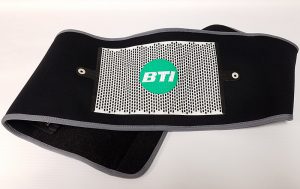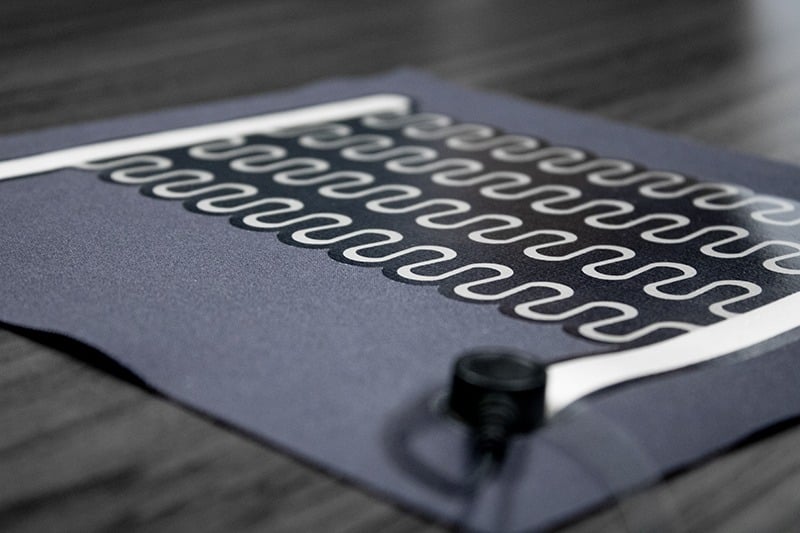Ever wonder what would be the best heater to use? It’s a common question that we hear at Butler Technologies Inc. Whether you need a heater for a medical wearable or for an aerospace application, we will help you pick the best flexible heater design for your application.
1 Wearable Jacket Heater to Keep Outdoor Workers Warm
- Fixed Resistance on TPU would be the best heater for heated jackets.
- Fixed Resistance Heaters need to have external controls that can fit into the pockets.
- Fixed Resistance Heaters also allow for stretching, so if the jacket is tight and stretches over the worker, they will still receive uniform heat.

2. Wearable Heater Brace for Pain Relief
- PTC on PET would be the best heater for pain relief garments.
- The brace fabric material will flex but won’t stretch, which is ideal for PET applications.
- PTC heaters are the “safest” without the need for external controls.
- PTC heaters are self-regulating. In the event that this heater technology would fail it would only quit heating. The temperature is set at a safe maximum temperature, usually between 100 and 170OF
3. Automotive Seat Heater
- Fixed Resistance on PET would be a good solution for seat heaters.
- The PET will allow for a small change in movement but is not as stretchable as TPU.
- Fixed Resistance on PET is also a more cost-effective option than PTC on PET because Fixed Resistance Heaters are simpler to produce.

4. Aerospace & Military Technology
- Kapton Heaters are a good solution for aerospace applications.
- Kapton Heaters need a heat sink, such as metal, which is typically already included in aerospace applications.
5. Sensor Defogging/Deicing

- Clear and Transparent Heaters would be the best option for sensor defogging and/or deicing.
- The clear transparent materials will be hot enough to melt ice and defog sensors to work more efficiently.
6. Etched Heaters
- Ideal for advanced thermal management applications and/or limited thickness installations.
- The foil itself can be as thin as .0005,” and the width of the etched foil element will typically be at least .010”.
- High-watt medical heater applications have been tested up to 115 watts per square inch on an etched foil heater. That high-watt heater is tested to be 50% higher than the next available etched foil heater.
Frequently Answered Questions about Flexible Heaters
What are traditional wire heaters and why are they outdated?
Traditional wire hearers involve a series of resistive wires tightly bound together to create the heating element. Innovative, flexible heaters use conductive inks, etched metal, and conductive films to create precision heating elements. Flexible heaters are safer in comparison to traditional wire heaters. Wire can become too hot in areas and in some cases, cause the surrounding material to catch fire.
How to control the temperature of a flex heater?
Most flexible heaters require external control to regulate the heater. PTC heaters are designed in a complex pattern that creates self-regulation. The PTC heaters are the only heaters that do not require external controls. BTI has battery and control partners to help manufacture the perfect solution for your custom application.
What are the power requirements?
The normal amount of power required for heaters to work properly is a 12-24 volt battery pack. However, the voltage can be lower depending on the application. There is always a tradeoff between runtime, operating temperature, and battery size/weight. The hotter you would like to run the heater, or the longer you want the heater to operate, the larger the required battery pack will need to be. However, if you require a slimmer, lightweight battery, you need to make concessions in either run time or operating temperature. Engineers will balance these options to meet your requirements.
What is the most flexible option for a heater?
The most flexible heater option is to use TPU as a substrate. Fixed Resistance Heaters can be configured to accommodate the flexibility of TPU.
Meet the Author

Ashley Foster is a graduate student at Slippery Rock University, where she earned her Bachelor’s degree in Business Administration, majored in Business Management, and minored in Marketing. While Ashley was studying at SRU, she found a passion for marketing. She loves to spend her free time traveling and hiking with friends. Ashley is also the Vice President of Programming for the American Marketing Association, Pittsburgh Chapter, and an active alumni member of FCCLA.